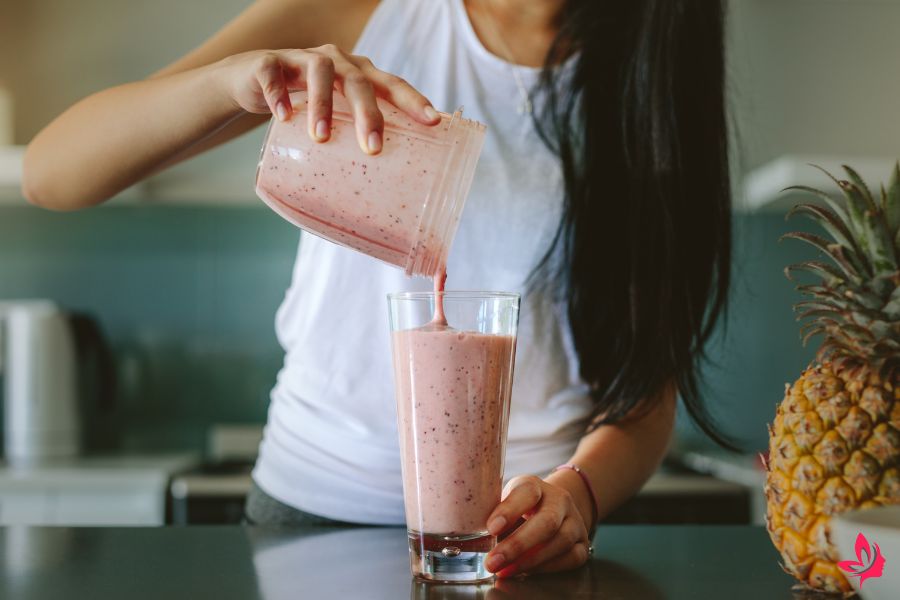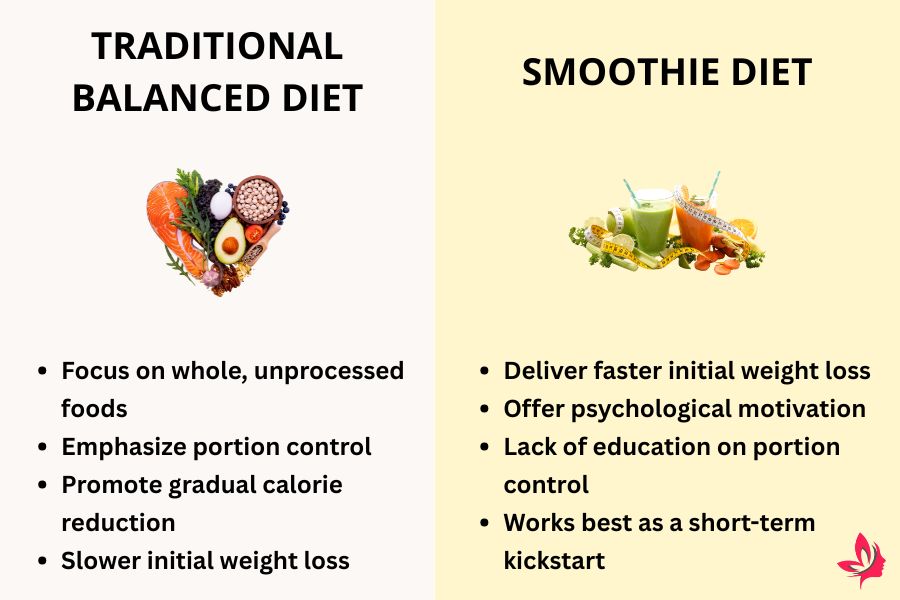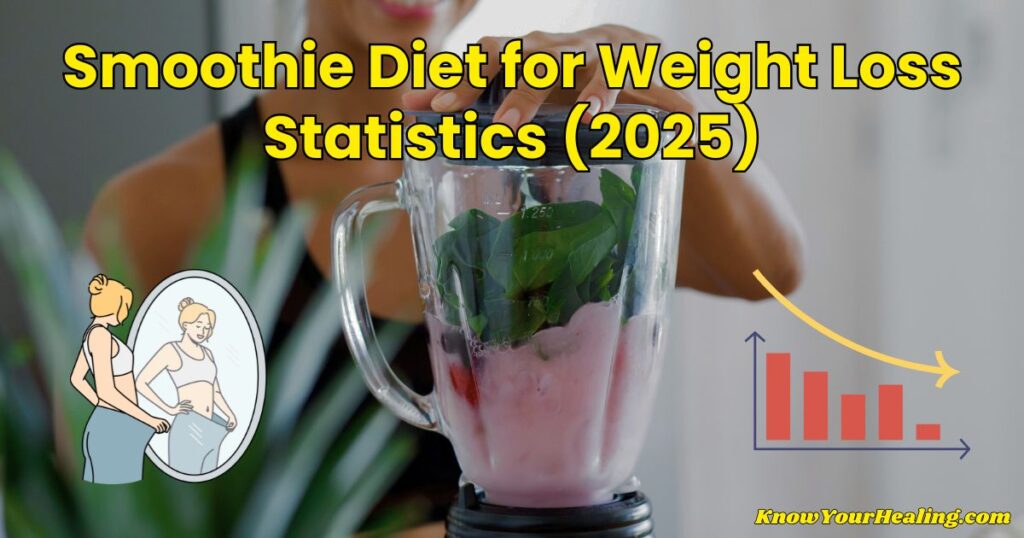The smoothie diet has become one of the most searched weight loss programs online.
It promises rapid results through meal replacement shakes and simple protocols. But behind the viral before-and-after photos lies a more nuanced reality.
What does the actual data tell us about smoothie diets for weight loss? Are the promised results realistic, or are dieters setting themselves up for disappointment?
This guide examines the 21-Day Smoothie Diet program, drawing on insights from research studies conducted between 2024 and 2025.
We’ll discuss market statistics and clinical trials, giving evidence-based insights to help you determine if this popular diet is a suitable fit for your weight loss journey.
What the Smoothie Diet for Weight Loss Promises

Understanding the 21-Day Smoothie Diet Program
The 21-Day Smoothie Diet ranks among the most popular structured approaches to weight loss through liquid meal replacement. Participants replace two meals daily with nutrient-dense smoothies while eating one solid meal.
Many versions include an optional detox phase during the first few days, intensifying calorie restriction by replacing all three meals with smoothies.
The program provides recipe guides featuring fruits, vegetables, protein powders, and healthy fats designed to keep you full while maintaining a significant calorie deficit.
Most plans range from 1,200 to 1,500 calories daily—substantially lower than the average adult’s maintenance intake of 2,000 to 2,500 calories.
You’ll typically follow a structured weekly plan with designated smoothie recipes for breakfast and lunch, then eat a sensible dinner emphasizing lean proteins, vegetables, and whole grains.
The simplicity appeals to busy people who struggle with meal planning and calorie counting.
The Core Concept: Meal Replacement and Calorie Control
The smoothie diet operates on a straightforward principle: create a calorie deficit through controlled meal replacement. When you consume fewer calories than your body burns, weight loss becomes inevitable.
Smoothies serve as an efficient vehicle for calorie restriction. They provide measurable portions, eliminate decision fatigue around meals, and pack in optimized nutrition.
The liquid format offers benefits beyond simple calorie control. Blended foods require less digestive energy, potentially leaving you energized rather than sluggish after meals.
A high fiber content from fruits and vegetables promotes feelings of fullness, while protein additions help preserve muscle mass during weight loss. Healthy fats from avocado, nut butters, or chia seeds provide essential nutrients and extend satiety.
The effectiveness hinges entirely on maintaining that calorie deficit. A smoothie packed with multiple bananas, excessive nut butter, and sweetened protein powder can easily hit 600-800 calories. Success depends on adhering to the recipe carefully and maintaining honest portion control.
The Claims vs. Reality
Marketing materials frequently promise dramatic results: “Lose up to 16 pounds in 21 days!” or “Drop two dress sizes in three weeks!” These headlines drive significant interest but set unrealistic expectations.
Most participants experience more modest results. While some individuals experience substantial weight loss initially, much of it is due to water weight reduction and glycogen depletion rather than pure fat loss.
A realistic expectation? Three to six pounds during 21 days when following the program correctly. Still meaningful progress, but far from the advertised extremes.
Individual results vary dramatically based on starting weight, metabolic rate, activity level, and adherence.
Someone with significant weight to lose may lose 10-15 pounds in three weeks, particularly if they previously consumed more than 3,000 calories daily. Someone at a moderate weight might struggle to lose more than two to three pounds despite perfect compliance.
The gap between marketing promises and typical outcomes creates frustration. Many participants blame themselves for “failing” when they don’t achieve advertised results.
Expert Take on Short-Term Diets
Nutrition professionals approach the smoothie diet with cautious optimism. The program can jumpstart weight loss and break unhealthy eating patterns, but sustainability remains a concern.
Registered dietitians emphasize that any weight loss approach must transition into long-term lifestyle changes. Short-term programs provide initial motivation and visible results.
Without a maintenance plan, participants often regain weight once they return to previous habits.
The restrictive nature raises red flags. Completely replacing meals with liquids doesn’t teach portion control skills or help develop healthier relationships with solid food.
The reduced chewing and eating time may diminish meal satisfaction, potentially leading to compensatory overeating during the solid meal or after the program ends.
Many experts suggest using smoothie diets as a partial strategy. Replace one meal a day with a smoothie in the long term, while focusing on balanced, whole-food meals for the rest of the day.
This hybrid approach maintains benefits while promoting sustainable habits.
Why the Program Attracts So Many Diet Seekers
The smoothie diet draws massive interest for several compelling reasons.
The simplicity proves irresistible. Rather than calculating macros, weighing portions, or decoding nutrition labels, you blend and drink. This removes decision paralysis and reduces the mental burden of dieting.
The promise of fast results provides powerful motivation. In an era of instant gratification, waiting months to see changes feels unbearable. The smoothie diet offers visible progress within just a few days.
Smoothies enjoy a “health halo” in popular culture. They’re associated with fitness enthusiasts, wellness influencers, and clean eating movements.
Choosing a smoothie diet feels like joining a community of health-conscious individuals rather than engaging in a diet of deprivation.
The program’s temporary nature makes it psychologically manageable. Committing to three weeks feels achievable, even for those who’ve struggled with long-term dietary changes.
2024–2025 Smoothie Diet Statistics and Market Trends

Global Smoothie Market Growth
The global smoothie market exhibits robust growth, reflecting an increasing consumer interest in convenient, health-oriented food options.
Table 1: Global Smoothie Market Valuations in 2024
| Research Source | Valuation (USD Billion) | Notes |
|---|---|---|
| Towards F&B | 13.58 | Based on retail and packaged smoothie analysis |
| Precedence Research | 13.71 | Includes smoothie bars and at-home products |
| Market Data Forecast | 16.15 | Broadest scope including meal replacement shakes |
| Overall Range | 13.58 – 16.15 | Reflects variation by methodology and market segment |
Towards F&B estimated the global smoothies market at $13.58 billion in 2024. Precedence Research calculated the figure to be $13.71 billion. Market Data Forecast projected the highest valuation at $16.15 billion.
These variations reflect different approaches to categorizing smoothie products—some studies include only retail smoothie bars, while others incorporate packaged smoothies, meal replacement shakes, and at-home ingredients.
Table 2: Global Smoothie Market Forecast for 2025
| Research Source | Projected Valuation (USD Billion) | Estimated Growth Rate | Notes |
|---|---|---|---|
| Towards F&B | 14.86 | 9% | Based on steady expansion in retail and packaged segments |
| Precedence Research | 14.99 | 9.3% | Reflects continued consumer demand for health-focused beverages |
| Market Data Forecast | 17.78 | 10% | Includes meal replacement and on-the-go smoothie products |
| Overall Range | 14.86 – 17.78 | ≈9–10% annual growth | Indicates strong, consistent market expansion into 2025 |
Forecasts for 2025 predict continued expansion. Projections range from $14.86 billion (Towards F&B) to $17.78 billion (Market Data Forecast), representing annual growth rates between 9% and 10%.
Key Growth Drivers of the Smoothie Diet Market
- Health Awareness: Rising focus on clean, nutrient-rich eating
- Busy Lifestyles: Demand for quick, convenient nutrition
- Higher Incomes: Growing spending in developing markets
- Smart Marketing: Major chains driving smoothie popularity
- Weight Loss Trend: Meal replacements fueling steady growth
Rise of Smoothie Bars and Health Brands
The physical retail presence of Smoothie Culture has expanded dramatically.
According to IBISWorld data, the United States supported approximately 5,529 juice and smoothie bar establishments in 2024. These businesses employed over 62,415 people and generated $4.4 billion in revenue. Consumers are willing to pay premium prices for professionally prepared smoothie products.
These numbers will grow in 2025. Establishment counts have reached 5,709 locations, with the market size increasing to $4.5 billion. This steady expansion occurs despite general retail challenges.
The phenomenon extends globally. Australia’s juice and smoothie bar market reached $620.4 million AUD (approximately $414 million USD) in 2024, with expectations of growth to $631 million AUD in 2025. For a country with only 26 million people, this represents significant per capita spending.
Major chains, such as Jamba Juice, Smoothie King, and Tropical Smoothie Café, have established national presences. Countless independent operators fill local markets. These businesses capitalize on the perception of smoothies as healthier alternatives to fast food.
The success of physical smoothie retail validates consumer demand and helps create a cultural normalization around smoothie consumption.
Social Trend: Are Smoothies Losing or Gaining Buzz?
Social media metrics paint a complex picture of smoothie popularity.
According to Tastewise, which analyzes online conversations around food topics, social mentions of smoothies declined by 37.41% year-over-year in 2024. This dramatic drop might suggest waning interest.
However, actual consumption and restaurant integration continue growing. Tastewise data shows 13.55% of restaurants globally feature smoothies on their menus. This substantial penetration indicates mainstream acceptance.
The decline in social media usage likely reflects market maturation rather than rejection. When smoothies first gained popularity, they generated significant social sharing as novelty items.
As they’ve become normalized, people continue consuming them without posting about each smoothie experience.
The decline in general smoothie conversation doesn’t necessarily correlate with reduced interest in smoothie diets specifically. Weight loss programs often generate different social patterns, which are frequently discussed in private groups or forums rather than public social media posts.
Smoothies remain culturally relevant and commercially viable, despite a decline in social media hype.
Health Results from Meal-Replacement Studies
Clinical research provides the most reliable evidence for evaluating the effectiveness of the smoothie diet.
A significant 2024 randomized controlled trial published in Nutrients by Chen et al. examined meal replacement products for weight management among adults with obesity in China. The study compared three groups over 90 days: a meal replacement group, a diet control group, and a normal diet group.
Results demonstrated clear advantages for structured meal replacement approaches similar to smoothie diets.
Table 3: Weight Loss Results from the 2024 Meal Replacement Study
| Group | Most significant overall reduction among groups | Mean Weight Loss (kg) | Mean Weight Loss (lbs) | Key Observation |
|---|---|---|---|---|
| Meal Replacement Group | 45 days | 4.44 | 9.8 | Significant early loss, aligns with smoothie diet claims |
| Meal Replacement Group | 90 days | 7.38 | 16.3 | Significant early loss aligns with smoothie diet claims |
| Diet-Control Group | 90 days | 4.08 | 9.0 | Moderate loss through calorie restriction alone |
| Normal-Diet Group | 90 days | 0.97 | 2.1 | Minimal change without dietary adjustments |
Participants in the meal replacement group achieved a mean weight loss of 4.44 kg (approximately 9.8 pounds) at 45 days. At 90 days, they lost 7.38 kg (approximately 16.3 pounds). These results closely align with the upper range of claims made by 21-day smoothie diet programs.
The diet-control group followed a conventional calorie-restricted diet without meal replacements. They lost 4.08 kg (approximately 9 pounds) at 90 days—significantly less than the meal replacement group despite similar calorie targets. The normal-diet control group lost only 0.97 kg (approximately 2.1 pounds) over the same period.
These findings suggest structured meal replacement offers advantages beyond simple calorie reduction. Possible explanations include better adherence due to reduced decision fatigue, more consistent calorie intake without estimation errors, and improved nutrient timing.
The study also measured additional health markers beyond weight. The meal replacement group showed improvements in glycolipid metabolism, indicating potential cardiovascular benefits.
Important caveats apply. The study monitored participants closely with regular check-ins, used specifically formulated meal replacement products designed for nutritional completeness, and lasted only 90 days.
Long-term sustainability and weight maintenance after discontinuing meal replacements remain separate questions.
How Smoothie Diets Compare to Traditional Weight Loss Methods
Smoothie diets occupy a unique middle ground between conventional weight loss approaches.
Key Traits of Traditional Balanced Diet Methods
- Focus on whole, unprocessed foods for nutrient-rich eating
- Emphasize portion control rather than strict elimination
- Promote gradual calorie reduction over extreme restriction
- Include all food groups, maintaining meal variety and satisfaction
- Deliver slower initial weight loss (1–2 pounds per week) but better long-term maintenance
Research consistently shows that gradual weight loss accompanied by behavioral changes produces more durable results. A comprehensive meta-analysis found participants who lost weight quickly were more likely to regain it within one to two years compared to those who lost weight gradually while developing new eating habits.
Key Insights on Smoothie Diet Effectiveness
- Deliver faster initial weight loss due to more substantial calorie restriction
- Offer psychological motivation through quick, visible results
- Lack of education on proper food selection and portion control
- Do not build long-term eating behavior skills for sustained weight management
- Works best as a short-term kickstart, not a standalone lifelong strategy
The ideal approach may combine both strategies. Use a smoothie diet as a kickstart to generate momentum, then transition to a balanced whole-food approach for maintenance.
Some individuals successfully maintain one smoothie meal daily indefinitely while learning to manage solid meals more effectively.
Another consideration involves muscle preservation. Adequate protein intake and resistance training prove essential for maintaining lean body mass during weight loss.
Well-designed smoothie diets can include sufficient protein through Greek yogurt, protein powder, or silken tofu.
Poorly constructed plans that focus primarily on fruits and vegetables may lead to a protein deficiency, resulting in both muscle loss and fat loss.
Traditional balanced diets more naturally include adequate protein through regular meals featuring fish, poultry, legumes, and other whole-food sources.
Should You Try the 21-Day Smoothie Diet?

Benefits Backed by Short-Term Studies
Clinical evidence and anecdotal reports identify several legitimate benefits of properly implemented smoothie diets.
Benefits of Smoothie Diets on Energy and Satiety
- Sustained Energy: Many participants experience steady energy levels throughout the day, compared to the post-meal fatigue often associated with heavier foods.
- Easy Digestion: Blended foods require less digestive effort, allowing for more energy to be allocated to other activities.
- High Fiber Content: Promotes fullness despite fewer calories by slowing gastric emptying.
- Hormonal Balance: Fiber helps trigger natural signals of satiety, reducing overeating.
- Extended Fullness: When combined with adequate protein and healthy fats, smoothies keep you satisfied for several hours.
The convenience factor cannot be overstated. Preparation time for most smoothies ranges from five to ten minutes, including cleanup.
This efficiency makes the program accessible to busy professionals, parents, and others who struggle to prepare elaborate healthy meals.
Smoothies offer a convenient way to consume nutrients that many people typically underconsume. Leafy greens, berries, seeds, and other nutrient-dense ingredients blend seamlessly into palatable combinations.
The structured nature removes decision fatigue. Research in behavioral psychology demonstrates that decision-making depletes willpower reserves.
By eliminating meal decisions for two-thirds of daily eating occasions, smoothie diets allow for mental energy to be preserved for other aspects of health behavior change.
Risks and Common Pitfalls
Smoothie diets carry several risks that merit serious consideration.
Table 4: Common Risks and Concerns of Smoothie Diet Programs
| Risk / Concern | Description | Potential Impact |
|---|---|---|
| Nutrient Deficiency | Overemphasis on fruits can lead to excessive sugar intake and lack of protein, healthy fats, and essential vitamins. | May cause fatigue, nutrient imbalance, and weakened immunity. |
| Muscle Loss | Inadequate protein intake (below 0.7–1 g per pound of body weight) leads to muscle breakdown for energy. | Slows metabolism and increases the chance of regaining fat instead of muscle. |
| Disrupted Satiety Signals | A sudden increase in fiber can cause bloating, gas, and stomach upset during the first few days. | Liquid-only diets bypass the need for chewing, thereby reducing hormonal and neural signals of fullness. |
| Digestive Discomfort | Sudden fiber increase can cause bloating, gas, and stomach upset during the first few days. | Temporary discomfort that may discourage continuation of the diet. |
| Blood Sugar Fluctuations | Fruit-heavy smoothies can cause glucose spikes and crashes, especially for diabetics. | Leads to hunger swings, fatigue, and poor energy regulation. |
| Rebound Weight Gain | Returning to old habits after the program without a transition plan. | Most participants regain lost weight within a few months. |
Smart Ways to Modify the Program
Several evidence-based modifications can enhance the safety and effectiveness of the smoothie diet.
Table 5: Smart Modifications for a Safer and More Effective Smoothie Diet
| Guideline | Key Recommendation | Benefit |
|---|---|---|
| Increase Protein Intake | Include 20–30g of protein per smoothie using Greek yogurt, protein powder, tofu, or protein-rich plant milk. | Preserves muscle mass and promotes long-lasting fullness. |
| Add Healthy Fats | Use nut butter, avocado, flaxseeds, or chia seeds in moderation. | Limit to 1–2 cups of fruit; choose lower-sugar options, such as berries, instead of tropical fruits. |
| Control Fruit Portions | Develop a post-program plan to reintroduce regular meals gradually. | Reduces sugar intake while maintaining fiber and antioxidants. |
| Include Leafy Greens | Add spinach, kale, or Swiss chard to smoothies. | Increases vitamins, minerals, and fiber with minimal calories. |
| Replace One Meal Daily | After the initial 21 days, switch to one smoothie meal per day. | Maintains results while allowing more dietary flexibility. |
| Plan a Transition Strategy | Create a post-program plan for reintroducing regular meals gradually. | Prevents rebound weight gain and encourages long-term habits. |
| Stay Physically Active | Incorporate resistance training and regular exercise. | Supports muscle retention, metabolism, and sustained weight maintenance. |
Realistic Expectations and Maintenance
Setting appropriate expectations proves crucial for satisfaction and long-term success.
A realistic goal for the 21-day smoothie diet is typically to lose three to six pounds for most individuals. Those with significant weight to lose might achieve eight to ten pounds.
Those closer to their goal weight might lose two to four pounds. All represent meaningful progress.
The first week typically yields the most dramatic results, often resulting in a loss of three to five pounds, primarily due to water weight and reduced food volume in the digestive system.
Weight loss usually slows during weeks two and three as the body adapts. This pattern is normal.
Measurements beyond the scale often reveal progress invisible to weight alone. Many participants notice improved energy, better sleep, clearer skin, reduced bloating, and looser-fitting clothes even during weeks when weight loss plateaus.
The critical period begins after day 21. Studies show most weight regain occurs within three to six months after completing short-term diets.
Successful maintainers share common characteristics: they continue to be mindful of their calorie intake, maintain regular physical activity, weigh themselves weekly to catch small gains, and develop personalized strategies for managing trigger situations.
Consider the 21-day program as an educational tool rather than a comprehensive solution. Use it to distinguish between true hunger and emotional eating.
Experiment with nutritious ingredients you might not have tried before. Prove to yourself that you can follow a structured plan.
After completion, many successful participants adopt a “modified smoothie lifestyle” rather than abandoning smoothies entirely.
This might mean having a smoothie for breakfast most days, as it’s convenient and nutritious, while focusing behavioral change efforts on improving the quality of lunch and dinner.
Final Thoughts: Evidence-Based Balance
The smoothie diet for weight loss represents a tool rather than a miracle solution. Like any tool, its effectiveness depends on proper use within a larger strategy for health improvement.
The data clearly show structured meal replacement approaches can produce meaningful short-term weight loss, particularly compared to unstructured dieting or maintaining typical eating patterns.
However, no short-term diet alone produces permanent weight loss without behavioral changes that extend beyond the program duration.
The smoothie diet’s value lies primarily in jumpstarting motivation, simplifying initial calorie restriction, and potentially helping individuals break unhealthy eating patterns.
Success involves approaching the program with realistic expectations, implementing smart modifications that enhance nutritional adequacy, and developing a clear maintenance plan before completing the 21 days.
Those who view it as a temporary tool within a larger lifestyle transformation process achieve better outcomes than those expecting a quick fix. If you decide to try the smoothie diet, do so intelligently.
Prioritize protein and healthy fats alongside fruits and vegetables. Don’t eliminate solid meals—maintain at least one balanced whole-food meal daily. Listen to your body and modify the program if you experience concerning symptoms.
Use the structure and results as a foundation for building lasting habits rather than expecting the program alone to solve weight struggles permanently.
The market data demonstrating billions in smoothie industry revenue and thousands of establishments suggests genuine consumer value.
People continue to choose smoothies because they offer real benefits: convenience, nutrition, and, yes, weight loss results when used appropriately.
The question isn’t whether smoothie diets work—research confirms they can. The real question is whether you’re ready to use this tool as part of a comprehensive, sustainable approach to health.

